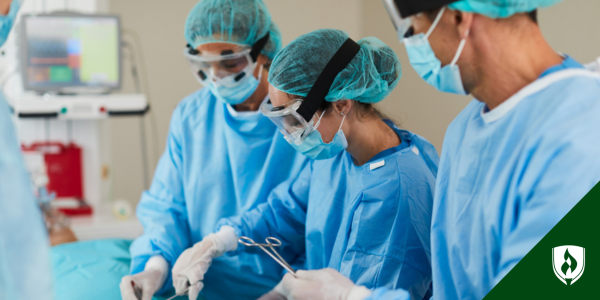
So many entry-level jobs are just that: entry-level. You learn some valuable skills and gain some experience, but after a few years it can be hard to picture a future for yourself, still working at the same place you started out.
If you feel like you’re stuck in a dead-end role, you’re not alone. You’re searching for what’s next, and you’re considering a healthcare career in surgical technology. Your only concern? That it’ll lead to that same feeling of being stuck, with no room for growth.
You’re not just looking for a new career, you’re looking for a new career path—and we’ve got you covered. We spoke with Jill Teodoro, Program Coordinator School of Health Sciences at Rasmussen University for insights about the career.
Here are some common career trajectories for surgical technologists (sometimes mistakenly called surgical technicians) from entry-level to advanced, including the education requirements, typical responsibilities and different specializations that come with each stage.
Surgical technology career path: how it looks when you start
The entry-level requirements for surgical technologists typically include graduating from an associate degree program in surgical technology and passing a certification exam. Of course, it also requires having a solid idea of what a surgical technologist program entails.
Choose a surgical technology program
Picking out a new career path isn't something to take lightly, especially when it involves obtaining a degree. The good news? Surgical technology is specific enough that most students are well-aware of what they're signing up for.
“95% of students who come to us know what they’re getting into,” says Teodoro. “Before they start fundamentals, we do group interviews to reiterate what the program will require and what the job is like.”
The application process can also give you an idea of what to expect. Before getting into a surgical technologist program, you’ll typically need to take the Test of Essential Academic Skills (TEAS). This is a standard exam required by many nursing and health science programs, but exceptions can include the completion of other exams (HESI® A2 Health Education Systems, Inc. Admissions Assessment) as well as the completion of other relevant associate or bachelor’s degrees. These requirements (and any potential exceptions) vary by program.
For more detail on surgical technology program entrance requirements, check out Do You Have to Take the TEAS Test to Become a Surgical Tech? + Other Entrance Requirement FAQs.
Become a certified surgical technologist
A good surgical technology program will prepare you with hands-on lab skills, a fair bit of procedure understanding and clinical experiences. At the end of your program, you’ll be prepared to take a national surgical technological certification exam.
Though every program is different, the Rasmussen University surgical technologist program trains students in four focused skill areas of surgical technology.
- Preparing operating rooms
- Assisting surgeons during surgery
- Sterilization techniques
- Compassionate patient care.
As a certified surgical technologist (CST®), you’ll also need to know the medical terminology for hundreds of surgical instruments—and you'll be well equipped to work in a laboratory or operating room. By the time you finish your clinical experiences, you’ll also have lots of real-life experience backing you up. (And potentially some insight and connections to prospective employers).
Gain experience as an entry-level surgical tech
An entry-level surgical tech will spend time preparing sterile processing areas, preparing and cleaning operating rooms and may help prepare patients for surgery. They’ll review the supply list and the surgeon’s preferences prior to surgery, and they’ll pass the surgeon and surgical team the necessary tools and instruments throughout an operation.
As each surgery comes to a close, they'll review the inventory of surgical instruments and remove them for sterilization. Additionally, surgical technologists assist in applying bandages and transporting patients out of the operating room.
Early on, most surgical technologists work primarily on pre- and post-surgical tasks, and the surgical procedures they scrub in for may mostly be routine operations—but there’s plenty of room to grow.
Surgical technology career path: mid-career options
Once you’re further into your career and ready for a mid-level role, there are a few different directions you can take—and a few different areas you can specialize in.
Transition to an agency role: traveling or staying nearby
“There are a couple of options,” says Teodoro. “You can go and do agency, which is like being a substitute. If a hospital is low on staff, you’d sub in—it could be for a day, a week, a month, a year. But the pay is significantly higher."
While it offers a slightly unpredictable schedule, agency work often comes with increased compensation and can lead to some exciting opportunities. If you choose to pursue life as an agency tech, you'll have the option to stay local or travel around the country as a surgical technologist.
"You can do local," explains Teodoro. "I did agency for two years, and I told them ‘I don't want to go further than 20 miles from my house.’ But I’ve had students in agency go to Hawaii, Boston, Colorado. The agencies pay for room and board, if you want to travel and make more money.”
Become a first assistant
Another common next step for entry-level surgical techs is to become first assistants. This means you’re the primary surgical technician in the operating room, taking on additional responsibility and performing more advanced tasks.
This often requires additional education, training or experience, which you may or may not gain organically throughout the first few years of your career.
Advance as a central supply supervisor
Many surgical techs also move on to become central supply supervisors. This is usually regarded as a step above first assistant, and it comes with added leadership responsibility.
In this role, you’ll supervise the employees responsible for either all central supply functions or one specific function. This can be anything from sterilization to equipment distribution to linen supply.
In order to become a central supply supervisor additional requirements either academic or work experience are needed beyond earning Rasmussen’s Surgical Technologist Associate’s degree
Pursue a surgical specialization
Beyond moving up in the ranks to a supervisory position in the OR, you can also start to hone in on the specific types of surgeries you’d like to scrub in on.
If you’re interested in getting even deeper into the nitty gritty of surgical assisting and participating in more advanced surgical operations, you may choose to specialize in one of three surgical areas. In order of complexity, the three most popular pathways include vascular, open heart and neuro.
There are also tons of different options for where and how you want to work if you look around at where surgeries take place. You could transition from a hospital OR to a dental clinic to assist on oral surgeries for example.
Or if you started out in an outpatient surgery center that focuses on bone work (knee surgeries, hip replacements, etc…) you could try something totally different and work in a children’s hospital.
Surgical tech career path: advanced roles
If you’re interested in obtaining a bachelor's degree in healthcare, (surgical tech programs are typically associate’s degree programs) there will be even more opportunities available to you.
Teodoro shares the possibility of becoming an operating room manager in outpatient surgical centers, or pursuing surgical assisting. As a surgical assistant, you'll actively help perform procedures as opposed to passing instruments to the surgeon.
Become a surgical assistant1
Surgical assistants perform a range of hands-on tasks during surgery. Just a few of these can include placing and securing retractors, packing the surgical field, suctioning, irrigating or sponging, clamping and cauterization and using sutures and other closing techniques.
Becoming a full-fledged surgical assistant requires additional education specific to the role, but it can be a promising pathway for someone more focused on the surgery side of surgical tech than the management side—and it's a fascinating way to assist surgeons performing life-saving procedures.
Branch into academia
Experienced surgical technologists can also consider roles outside the operating room. Surgical technology programs need seasoned professionals to become professors and teach their surgical technology students.
Education and experience requirements can vary a lot depending upon the university. If this career prospect interests you, look into the education and experience requirements. You could pick up hours as an adjunct professor or become a full-time faculty member or clinical coordinator in a school of health science.
Take the first step on your new career path
There are a ton of different directions you can go if you choose to become a surgical tech, and a range of career advancements to look forward to along the way. From central supply supervising to becoming a neuro specialist to traveling the country as an agency tech, it’s up to you to choose where the career takes you.
But all of that starts with getting into a surgical tech program. For more information on surgical tech programs, check out the article “9 Things You Should Know About Surgical Technologist Programs.”
Related Articles:
1Rasmussen University does not offer a Surgical Assisting program.




